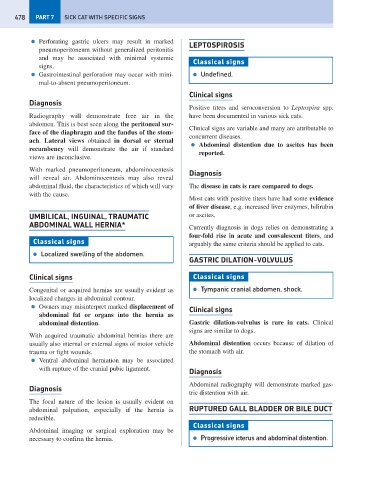Page 486 - Problem-Based Feline Medicine
P. 486
478 PART 7 SICK CAT WITH SPECIFIC SIGNS
● Perforating gastric ulcers may result in marked
LEPTOSPIROSIS
pneumoperitoneum without generalized peritonitis
and may be associated with minimal systemic
Classical signs
signs.
● Gastrointestinal perforation may occur with mini- ● Undefined.
mal-to-absent pneumoperitoneum.
Clinical signs
Diagnosis
Positive titers and seroconversion to Leptospira spp.
Radiography will demonstrate free air in the have been documented in various sick cats.
abdomen. This is best seen along the peritoneal sur-
Clinical signs are variable and many are attributable to
face of the diaphragm and the fundus of the stom-
concurrent diseases.
ach. Lateral views obtained in dorsal or sternal
● Abdominal distention due to ascites has been
recumbency will demonstrate the air if standard
reported.
views are inconclusive.
With marked pneumoperitoneum, abdominocentesis
Diagnosis
will reveal air. Abdominocentesis may also reveal
abdominal fluid, the characteristics of which will vary The disease in cats is rare compared to dogs.
with the cause.
Most cats with positive titers have had some evidence
of liver disease, e.g. increased liver enzymes, bilirubin
UMBILICAL, INGUINAL, TRAUMATIC or ascites.
ABDOMINAL WALL HERNIA* Currently diagnosis in dogs relies on demonstrating a
four-fold rise in acute and convalescent titers, and
Classical signs arguably the same criteria should be applied to cats.
● Localized swelling of the abdomen.
GASTRIC DILATION-VOLVULUS
Clinical signs Classical signs
Congenital or acquired hernias are usually evident as ● Tympanic cranial abdomen, shock.
localized changes in abdominal contour.
● Owners may misinterpret marked displacement of
Clinical signs
abdominal fat or organs into the hernia as
abdominal distention. Gastric dilation-volvulus is rare in cats. Clinical
signs are similar to dogs.
With acquired traumatic abdominal hernias there are
usually also internal or external signs of motor vehicle Abdominal distention occurs because of dilation of
trauma or fight wounds. the stomach with air.
● Ventral abdominal herniation may be associated
with rupture of the cranial pubic ligament.
Diagnosis
Abdominal radiography will demonstrate marked gas-
Diagnosis
tric distention with air.
The focal nature of the lesion is usually evident on
abdominal palpation, especially if the hernia is RUPTURED GALL BLADDER OR BILE DUCT
reducible.
Classical signs
Abdominal imaging or surgical exploration may be
necessary to confirm the hernia. ● Progressive icterus and abdominal distention.

